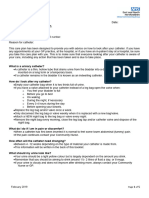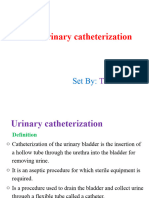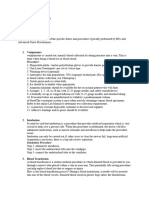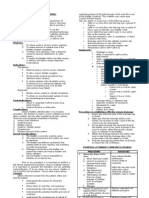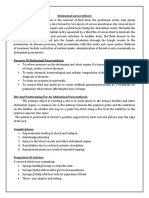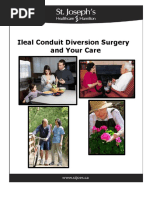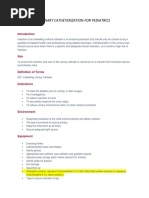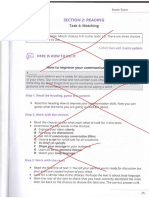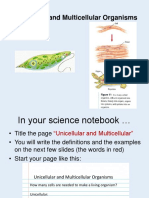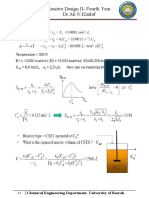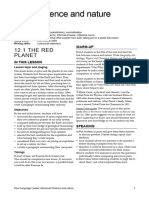Caring For A Nephrostomy at Home Guidelines For District Nurses 41.0.45 1
Caring For A Nephrostomy at Home Guidelines For District Nurses 41.0.45 1
Uploaded by
Zamzam IbrahimCopyright:
Available Formats
Caring For A Nephrostomy at Home Guidelines For District Nurses 41.0.45 1
Caring For A Nephrostomy at Home Guidelines For District Nurses 41.0.45 1
Uploaded by
Zamzam IbrahimOriginal Description:
Original Title
Copyright
Available Formats
Share this document
Did you find this document useful?
Is this content inappropriate?
Copyright:
Available Formats
Caring For A Nephrostomy at Home Guidelines For District Nurses 41.0.45 1
Caring For A Nephrostomy at Home Guidelines For District Nurses 41.0.45 1
Uploaded by
Zamzam IbrahimCopyright:
Available Formats
Department of Urology
Guidelines for Caring for a Nephrostomy at Home
District Nurses
The Urinary System
The urinary system is made up of several different parts including the kidneys
ureters the bladder and the urethra.
The kidneys sit at the back of the body, one on each side, just underneath the ribcage.
They filter your blood to remove waste products which they change into urine. Urine is
carried from each kidney through a fine tube called a ureter to the bladder where it is
stored. When you are ready to pass urine it leaves the bladder through a tube called
the urethra.
What is a Nephrostomy
A Nephrostomy is a thin plastic tube (catheter) that is inserted through the skin on your
back and into your kidney. It helps to relieve a build up of urine in the kidney, caused by
a blockage and prevents the kidney from being damaged. It drains urine directly from
one or both kidneys into a collecting bag outside your body. The bag has a tap so you
can empty it. Patients may still pass urine in the normal way even when they have a
nephrostomy tube, in one or both of the kidneys.
Why is a Nephrostomy tube needed?
A nephrostomy tube is needed when the ureter (the tube that connects the kidney to
the bladder) becomes blocked and urine cannot flow through from the kidney to the
bladder. This can be caused by a stone, cancer growth or stricture (narrowing).
How long can my Nephrostomy stay in for?
The Doctor will explain how long the nephrostomy tube is likely to remain in place. It
will depend on each patients individual situation. It will be removed if treatment can
relieve the blockage for example with a stent. A stent is a specially designed
hollow tube made of a flexible plastic material that is placed in the ureter (the tube
that connects the kidney to the bladder).
However some patients are not suitable to have treatment or a stent and in these
cases the nephrostomy will be permanent but will need to be changed periodically.
The blockage may resolve on its own, or the patient may need to undergo
treatment to relieve the blockage or the decision will be made to keep the
nephrostomy permanently and a date arranged for admission to hospital for a
change of nephrostomy tube or tubes.
Looking after a Nephrostomy
The nephrostomy tube will be stitched in place and will exit the skin from the side
of the patients back. The tube will be attached to a drainage bag which is usually
worn under your clothing and can either be strapped to the thigh or secured to
clothing with a safety pin. It is important NOT to leave the bag hanging as the
weight of the urine and any tugging may cause the nephrostomy tube to fall out.
Nephrostomy Care
The skin around the nephrostomy tube insertion site should be kept clean and to
prevent infection, place a sterile dressing around the site where the tube leaves the
skin. The dressing should be changed at least twice a week, especially if the
dressing becomes wet. The drainage bag should be changed weekly along with
the connection tube.
Patients may shower and bathe 48 hours after the tube has been inserted but try to
keep the tube site itself dry. Protect the skin with plastic wrap during showering or
bathing. After 14 days the patient may shower without any protection for the tube.
Please remember to insure the tube is secure at all times.
Swimming is not recommended as long as the tube is in place.
Dressing & Cleaning
1. Wash hands and prepare equipment.
Equipment: - Sterile Dressing Pack (with sterile gloves)
Sterile Normal Saline
Sterile Dressing
2. Apply non sterile gloves.
3. Gently remove old dressing from around the nephrostomy tube insertion
site, taking care not to pull on the tube.
4. Wash hands and apply sterile gloves.
5. Clean the skin gently with sterile normal saline and gauze.
6. Dry the surrounding skin well with sterile gauze and apply a new sterile (this
can be gauze) dressing and secure with tape (Mefix/Mepore).
7. Insure the nephrostomy tube is secure and attached to clothing/thigh to
avoid the nephrostomy being pulled out.
8. Dispose of clinical waste.
As the patient/relative becomes more confident with the nephrostomy tube they
maybe able to care for it themselves with guidance from the District Nurse.
Coping at home with a Nephrostomy
Once at home with their nephrostomy tube the patient will be able to carry on with
day to day activities. However they should:-
1. Always wash hands before changing the bag or the dressing.
2. Empty the nephrostomy bag approximately four or five times per day dependent
on how much is drunk. Empty the bag when it is 1/2 full to avoid it getting to full
and pulling.
3. Contact the GP/District Nurse if there is blood in the urine, if it looks cloudy or
smells strongly or if it is painful to pass urine the normal way. The patient may
have a urine infection that will need to be treated with antibiotics.
4. Drink plenty of fluids. The patient should aim to drink at least two litres per day
(around 4 pints) to help reduce the risk of infection.
5. Contact the GP/District Nurse if the area around the tube becomes
uncomfortable, looks red or swollen, or feels warm. These may be signs of
infection which will need treating.
6. If the tube comes out, which is unusual, or if it stops draining urine, contact your
GP/District Nurse.
Flushing the Tube
If the patient reports no drainage of urine from the tube and there has not been an
increase in the amount of urine passed normally the nephrostomy may need
flushing.
This should be carried out by the District Nurse/Practice Nurse.
Equipment: - Sterile Dressing Pack (with sterile gloves)
10ml Leu Lock Syringe
Leur lock
10mls Sterile Normal Saline
Alcohol Wipe
Clean Nephrostomy Bag
1. Check the tube and bag to make sure that there are no kinks that may be
causing mechanical obstruction to the drainage of urine. If there is a
physical obstruction that can easily be resolved then a flush may not be
necessary.
2. Check the end of the tube to see if it has got a luer lock cap on it.
3. Wash hands.
4. Open dressing pack and prepare equipment, draw the saline into the
syringe.
5. Remove the nephrostomy bag to allow for access to the distal end of the
tube.
6. Apply sterile gloves.
7. Where possible replace the luer lock prior to flushing to prevent introducing
infection. Alternatively wipe around the port with an alcohol wipe.
8. Gently apply even pressure, instil the saline into the nephrostomy tube.
Gentle aspiration of the tube may help to dislodge the blockage, excessive
pressure may cause bleeding.
9. Allow the saline/urine to flow out of the tube.
10. Apply a clean nephrostomy bag.
If there is no drainage from the nephrostomy tube over a 12 hour period the patient
should contact the GP/District Nurse who may need to contact the Doctor on call
for Urology at the hospital.
If the nephrostomy tube is prone to blocking on a regular basis then it may be
appropriate to flush the tube twice a week to prevent this.
Ordering Equipment
Patients returning home with a nephrostomy in situ will be sent with a spare bag
and connection tube but it is the responsibility of the GP/District Nursing to team to
order further supplies.
These are available on a FP10 (Community Prescription)
FP10 Code Nephsys. O2s Pip Code for chemist 305-1588
This is a complete system with an adult belt, 2x suspenders & 4 x 500ml bags.
The connectors and the bag come together and need to be changed on a weekly
basis.
The product is made by Manfred Sayer Helpline 01604 595696
Possible Complications
The risks of developing complications from having a nephrostomy are low.
Possible complications are infections, bleeding from the kidney or urine leaking
from the kidney and collecting in the abdomen.
Signs & Symptoms
Infections The skin around the insertion site becomes red, hot and swollen.
Blood in your urine, or it appears cloudy or smells strongly
Bleeding from the kidney Blood in the urine
Urine collecting in the abdomen the abdomen appears distended (swollen)
Are there any side effects?
Most procedures have a potential for side-effects. You should be reassured that,
although all these complications are well-recognised, the majority of patients do
not suffer any problems after a urological procedure.
Points of contact
The patients first point of call for advice should be the District Nurse/GP however
if you have any other questions, or require more information please contact
Edgefield ward on 01603 289962
Common (greater than 1 in 10)
Minor bleeding from the kidney (visible in the urine drainage
bag) Short lived discomfort in the kidney and at the insertion site
Occasional (between 1 in 10 and 1 in 50)
Leakage of urine around the catheter inside the abdomen
Blockage of the drainage tube
Generalised infection following insertion septicaemia (infection in the blood)
Rare (less than 1 in 50 )
Significant bleeding inside the abdomen requiring surgical
drainage. Displacement of the drainage tube
Failure to place the tube satisfactorily in the kidney requiring alternative
treatment (e.g. surgical insertion of a drainage tube)
Inadvertent damage to adjacent organs (e.g. stomach, bowel)
Hospital-acquired infection
The rates of hospital-acquired infection may be greater in high-risk patients e.g.
with long term drainage tubes, after removal of the bladder for cancer, after
previous infections, after prolonged hospitalisation or after multiple admissions.
Patients will be screened on admission to hospital and treated appropriately.
Issued: November 2013
Review: November 2015
Review date: November 2016
Reviewed by: Edgefield Charge Nurse
Urology Consultants
References; British Association of Urology Surgeons Website - www.baus.org.uk
The Christie NHS Foundation Trust
Macmillan Cancer Support Website www.macmillan.org.uk
This sheet describes a surgical procedure. It has been given to you because it relates to your condition and
may help you understand it better. It does not necessarily describe your problem exactly. If you have any
questions please ask your doctor.
You might also like
- Catheter Care PlanDocument5 pagesCatheter Care PlanDilsha Guruge100% (1)
- Tracheostomy CareDocument10 pagesTracheostomy CareSharifa Al AmerNo ratings yet
- Caring For A Nephrostomy Tube at HomeDocument4 pagesCaring For A Nephrostomy Tube at HomeUmi KrisdyantiniNo ratings yet
- A Nursing Skill OutputDocument5 pagesA Nursing Skill OutputAnonymous 2IDZlcsjQNo ratings yet
- Nephrostomy Tube Care: Roll No Anupama Thapa - 6 Asmita Awal - 7Document22 pagesNephrostomy Tube Care: Roll No Anupama Thapa - 6 Asmita Awal - 7Prajina KansakarNo ratings yet
- Suprapubic CatheterDocument16 pagesSuprapubic CatheterMilica MilojevicNo ratings yet
- Urinary Catheter InsertionDocument4 pagesUrinary Catheter InsertionAngel SamonteNo ratings yet
- Urinary EliminationDocument9 pagesUrinary EliminationTuTitNo ratings yet
- Urinary CatheterizationDocument51 pagesUrinary CatheterizationRebira WorkinehNo ratings yet
- Urinary CatheterDocument21 pagesUrinary CatheterGiFt Wimolratanachaisiri0% (1)
- Caring For Your Nephrostomy Tube: Kidney StonesDocument10 pagesCaring For Your Nephrostomy Tube: Kidney StonesvishwanathNo ratings yet
- CatheterizationDocument31 pagesCatheterizationThe GreatNo ratings yet
- Tgs Chelsa Individu Mr. BingsDocument4 pagesTgs Chelsa Individu Mr. Bingsjeffriwahyudi91No ratings yet
- 6 Urinary EliminationDocument5 pages6 Urinary EliminationkhautedameNo ratings yet
- Abdominal ParacentesisDocument4 pagesAbdominal ParacentesisRashmi C S100% (1)
- Urinary Catheterization Nursing ProcedureDocument6 pagesUrinary Catheterization Nursing ProcedureDencel BarramedaNo ratings yet
- Urinary CatheterDocument4 pagesUrinary CatheterBindu SinghNo ratings yet
- Urinary Catheterization PrintableDocument5 pagesUrinary Catheterization Printablemaricris atunNo ratings yet
- Abdominal ParacentesisDocument5 pagesAbdominal ParacentesisVijith.V.kumar100% (1)
- Caring For Your Haemodialysis Catheter v2 07.2019 Web 1Document8 pagesCaring For Your Haemodialysis Catheter v2 07.2019 Web 1tobihoorNo ratings yet
- Urology Case 10th March 2024Document35 pagesUrology Case 10th March 2024tamzidshafi78No ratings yet
- Abdominal ParacentesisDocument14 pagesAbdominal ParacentesisMonika Joseph80% (5)
- How To Insert A CatheterDocument17 pagesHow To Insert A CatheterGreen ZeroNo ratings yet
- Presented by SAMAR ELYANDocument21 pagesPresented by SAMAR ELYANMarvin ReyesNo ratings yet
- Nasogastric Tube InsertionDocument11 pagesNasogastric Tube InsertionDiane Kate Tobias Magno100% (2)
- Urinary CatheterizationDocument11 pagesUrinary CatheterizationPamDavidGabrielNo ratings yet
- X Aga AaaaaaaDocument7 pagesX Aga AaaaaaaDuco Qabe WellmanNo ratings yet
- Insertion of TubesDocument29 pagesInsertion of Tubesqopcyrus10No ratings yet
- Foley CatherterDocument18 pagesFoley CathertergwynNo ratings yet
- Ileal Conduit Diversion Surgery PDFDocument28 pagesIleal Conduit Diversion Surgery PDFAnonymous XsuwLJNo ratings yet
- CATHETERIZATIONDocument13 pagesCATHETERIZATIONSarah Uy Caronan100% (1)
- (Document Title) : Group 4: Ilarde, Judegarcia, Krllopez, Klim Casing, Rychele BSN4 2019Document8 pages(Document Title) : Group 4: Ilarde, Judegarcia, Krllopez, Klim Casing, Rychele BSN4 2019qwerty24No ratings yet
- Urinary CatheterizationDocument37 pagesUrinary CatheterizationCharles100% (2)
- Evaluation ReviewDocument11 pagesEvaluation Reviewviwoyir626No ratings yet
- Surgical DrainsDocument8 pagesSurgical DrainsPolina EscandovinaNo ratings yet
- Urinary CatheterisationDocument26 pagesUrinary Catheterisationmadalina popaNo ratings yet
- Polyglycolic Acid Sutures, Polyglactin 910, Catgut, Poliglecaprone 25 and Polydioxanone SuturesDocument3 pagesPolyglycolic Acid Sutures, Polyglactin 910, Catgut, Poliglecaprone 25 and Polydioxanone SuturesAiza OronceNo ratings yet
- UrologyDocument9 pagesUrologyDrmirfat AlkashifNo ratings yet
- Surgical DrainsDocument3 pagesSurgical DrainsJerome ValdellonNo ratings yet
- Urinary CathDocument71 pagesUrinary Cathlouie roderosNo ratings yet
- Evaluation ReviewDocument11 pagesEvaluation Reviewviwoyir626No ratings yet
- CYSTOCLYSIS3Document9 pagesCYSTOCLYSIS3Alvin OccianoNo ratings yet
- Suture MaterialsDocument42 pagesSuture MaterialsAmirudin SanipNo ratings yet
- Urinary CatheterizationDocument35 pagesUrinary CatheterizationrnrmmanphdNo ratings yet
- 4 and 5-Urethral Catheterization Male and FemaleDocument32 pages4 and 5-Urethral Catheterization Male and FemaleCynxNo ratings yet
- Group 9Document16 pagesGroup 9y4jjvbqr9kNo ratings yet
- Rle ProceduresDocument12 pagesRle ProceduresChristie TirolNo ratings yet
- ACI Nephrostomy Jan13-1Document16 pagesACI Nephrostomy Jan13-1Zamzam Ibrahim100% (1)
- What Is A Tracheostomy Tube?Document5 pagesWhat Is A Tracheostomy Tube?Arizz Tia BaquinquitoNo ratings yet
- Urinary Catheterization For PediatricsDocument6 pagesUrinary Catheterization For PediatricsMichael Montinola100% (1)
- Urinary CatheterizationDocument5 pagesUrinary CatheterizationRita PokharelNo ratings yet
- Simulation ActivityDocument6 pagesSimulation Activityjustgraduate1408100% (1)
- CatheterizationDocument46 pagesCatheterizationJam Maj67% (6)
- Catheter Care TrainingDocument15 pagesCatheter Care TrainingAndrada MateiNo ratings yet
- Haematuria With Jo DarganDocument4 pagesHaematuria With Jo DarganTanaman PeternakanNo ratings yet
- DRILLINGDocument3 pagesDRILLING4gen_5No ratings yet
- Rules and Directions for the Employment of Injections in Various DiseasesFrom EverandRules and Directions for the Employment of Injections in Various DiseasesNo ratings yet
- A Simple Guide to Blood in Stools, Related Diseases and Use in Disease DiagnosisFrom EverandA Simple Guide to Blood in Stools, Related Diseases and Use in Disease DiagnosisRating: 3 out of 5 stars3/5 (1)
- WJCPv5i2 PDFDocument99 pagesWJCPv5i2 PDFZamzam IbrahimNo ratings yet
- ACI Nephrostomy Jan13-1Document16 pagesACI Nephrostomy Jan13-1Zamzam Ibrahim100% (1)
- NANDA 2015-2017 List November 2014Document6 pagesNANDA 2015-2017 List November 2014Zamzam IbrahimNo ratings yet
- Alamat Distributor Supplier Produsen Popok Dan PerlengkapaDocument2 pagesAlamat Distributor Supplier Produsen Popok Dan PerlengkapaZamzam IbrahimNo ratings yet
- Contoh Surat Resmi Dalam Bahasa InggrisDocument6 pagesContoh Surat Resmi Dalam Bahasa InggrisZamzam Ibrahim100% (2)
- The Dangers of Passive SmokingDocument2 pagesThe Dangers of Passive SmokingZamzam IbrahimNo ratings yet
- UKM Kabupaten BandungDocument2 pagesUKM Kabupaten BandungZamzam IbrahimNo ratings yet
- Mr. Zamzam Ibrahim Chairman of Student Council Bachelor Science Nursing Budi Luhur Institute of Health and SciencesDocument1 pageMr. Zamzam Ibrahim Chairman of Student Council Bachelor Science Nursing Budi Luhur Institute of Health and SciencesZamzam IbrahimNo ratings yet
- Contoh Kalimat Simple Present TenseDocument3 pagesContoh Kalimat Simple Present TenseZamzam Ibrahim100% (1)
- Leaflet Artritis ReumatoidDocument6 pagesLeaflet Artritis ReumatoidZamzam IbrahimNo ratings yet
- Successful TAR UC Student Loan Fund ApplicantsDocument4 pagesSuccessful TAR UC Student Loan Fund ApplicantsTI XiaoQiNo ratings yet
- Music Geography (1998)Document11 pagesMusic Geography (1998)canazoNo ratings yet
- Exam Tutor Textbook - 25-50Document23 pagesExam Tutor Textbook - 25-50Oleg DemianivNo ratings yet
- Unicellular and Multicellular Organisms 2013 PDFDocument14 pagesUnicellular and Multicellular Organisms 2013 PDFAdenaya EnochNo ratings yet
- Reactor Design II-Fourth Year DR - Ali N.Khalaf: Chemical Engineering Department - University of BasrahDocument11 pagesReactor Design II-Fourth Year DR - Ali N.Khalaf: Chemical Engineering Department - University of BasrahKORAMA KIEN100% (1)
- Limiting and Excess ReactantsDocument6 pagesLimiting and Excess Reactantsapi-316338270No ratings yet
- NLL Adv Tnotes U12Document16 pagesNLL Adv Tnotes U12Xeno deCuirNo ratings yet
- MAD101 Chap4Document105 pagesMAD101 Chap4Anagram SwipeNo ratings yet
- The Spanish Civil War: July 1936 - May 1939Document25 pagesThe Spanish Civil War: July 1936 - May 1939Ranjeet KumarNo ratings yet
- History of LogarithmsDocument1 pageHistory of LogarithmsMahima AgrawalNo ratings yet
- 1921 Flower Will-Power Personal Magnetism Memory TrainingDocument92 pages1921 Flower Will-Power Personal Magnetism Memory TrainingGabriel MendesNo ratings yet
- MastopathiaDocument21 pagesMastopathiaMichalis PloumidisNo ratings yet
- The Genesis of Baloch Nationalism Politics and Ethnicity in Pakistan, 19471977 (Sheikh, Salman Rafi)Document269 pagesThe Genesis of Baloch Nationalism Politics and Ethnicity in Pakistan, 19471977 (Sheikh, Salman Rafi)shumaq shoaibNo ratings yet
- Industrial InstrumentationDocument24 pagesIndustrial InstrumentationNHIÊN CÙ VĂNNo ratings yet
- SAP Chapter 4 - Purchasing ProcessDocument47 pagesSAP Chapter 4 - Purchasing ProcessmsjoyceroxaneNo ratings yet
- Sewage Cleaning Machine SynopsisDocument7 pagesSewage Cleaning Machine Synopsisvidyadhar GNo ratings yet
- 2.1 Fuels and Combustion PDFDocument39 pages2.1 Fuels and Combustion PDFKantilal MalwaniaNo ratings yet
- Manual Practic S9000 RO GealanDocument16 pagesManual Practic S9000 RO GealanAlexandru Pelin0% (1)
- Literature Review - 2024Document10 pagesLiterature Review - 2024Pratima MandadiNo ratings yet
- Lesson Plan: Aim: To Enable The Students To Describe and Understand Uniform Circular Motions and TheDocument3 pagesLesson Plan: Aim: To Enable The Students To Describe and Understand Uniform Circular Motions and TheMark JomarNo ratings yet
- Food LicenseDocument7 pagesFood Licensenatrajraj93No ratings yet
- Financial Performance Analysis of Nestle India LTD: Amal BijuDocument87 pagesFinancial Performance Analysis of Nestle India LTD: Amal BijuVranda AroraNo ratings yet
- Dwaikat Dan KodurDocument20 pagesDwaikat Dan KodurBaptista XimenesNo ratings yet
- 3rd English ExamDocument6 pages3rd English ExamVergil AlonNo ratings yet
- Lecture 15 Urban Ecology Number 2 NotesDocument2 pagesLecture 15 Urban Ecology Number 2 NotesFrancesco Antonio ANo ratings yet
- IGCARDocument2 pagesIGCARKathirselvamNo ratings yet
- Degree of ComparisonDocument12 pagesDegree of ComparisonRoni Rahmad siregarNo ratings yet
- Lecture 7Document23 pagesLecture 7Dis DeasNo ratings yet
- Vivaldi: Laudate Pueri Dominum, RV 600Document13 pagesVivaldi: Laudate Pueri Dominum, RV 600botmy banmeNo ratings yet
